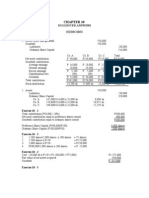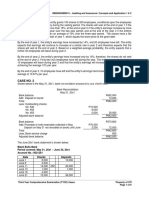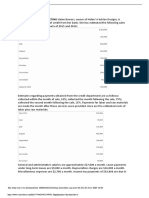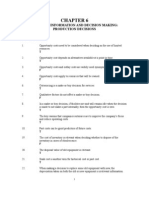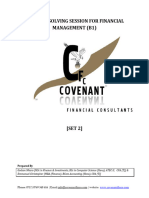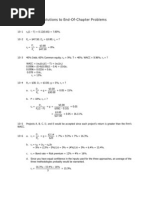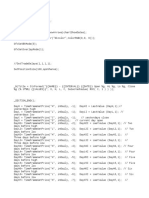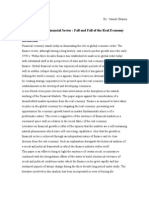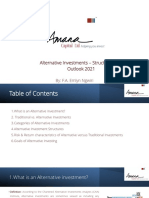Solutions To End-Of-Chapter Problems
Solutions To End-Of-Chapter Problems
Uploaded by
Yaam MedwedCopyright:
Available Formats
Solutions To End-Of-Chapter Problems
Solutions To End-Of-Chapter Problems
Uploaded by
Yaam MedwedOriginal Title
Copyright
Available Formats
Share this document
Did you find this document useful?
Is this content inappropriate?
Copyright:
Available Formats
Solutions To End-Of-Chapter Problems
Solutions To End-Of-Chapter Problems
Uploaded by
Yaam MedwedCopyright:
Available Formats
Solutions to End-Of-Chapter Problems
10-1 rd(1 – T) = 0.12(0.65) = 7.80%.
10-2 Pp = $47.50; Dp = $3.80; rp = ?
Dp $3.80
rp = = = 8%.
Pp $47.50
10-3 40% Debt; 60% Common equity; rd = 9%; T = 40%; WACC = 9.96%; rs = ?
WACC = (wd)(rd)(1 – T) + (wc)(rs)
0.0996 = (0.4)(0.09)(1 – 0.4) + (0.6)rs
0.0996 = 0.0216 + 0.6rs
0.078 = 0.6rs
rs = 13%.
10-4 P0 = $30; D1 = $3.00; g = 5%; rs = ?
D1 $3.00
a. rs = +g= + 0.05 = 15%.
P0 $30.00
b. F = 10%; re = ?
D1 $3.00
re = +g = + 0.05
P0 (1 F) $30(1 0.10)
$3.00
= + 0.05 = 16.11%.
$27.00
10-5 Projects A, B, C, D, and E would be accepted since each project’s return is greater than the firm’s
WACC.
D1 $2.14
10-6 a. rs = +g= + 7% = 9.3% + 7% = 16.3%.
P0 $23
b. rs = rRF + (rM – rRF)b
= 9% + (13% – 9%)1.6 = 9% + (4%)1.6 = 9% + 6.4% = 15.4%.
c. rs = Bond rate + Risk premium = 12% + 4% = 16%.
d. Since you have equal confidence in the inputs used for the three approaches, an average of the
three methodologies probably would be warranted.
Chapter 10: The Cost of Capital Answers and Solutions 1
16.3% 15.4% 16%
rs = = 15.9%.
3
D1
10-7 a. rs = +g
P0
$3.18
= + 0.06
$36
= 14.83%.
b. F = ($36.00 – $32.40)/$36.00 = $3.60/$36.00 = 10%.
c. re = D1/[P0(1 – F)] + g = $3.18/$32.40 + 6% = 9.81% + 6% = 15.81%.
10-8 Debt = 40%, Common equity = 60%.
P0 = $22.50, D0 = $2.00, D1 = $2.00(1.07) = $2.14, g = 7%.
D1 $2.14
rs = +g= + 7% = 16.51%.
P0 $22.50
WACC = (0.4)(0.12)(1 – 0.4) + (0.6)(0.1651)
= 0.0288 + 0.0991 = 12.79%.
10-9 Capital Sources Amount Capital Structure Weight
Long-term debt $1,152 40.0%
Common Equity 1,728 60.0
$2,880 100.0%
WACC = wdrd(1 – T) + wcrs = 0.4(0.13)(0.6) + 0.6(0.16)
= 0.0312 + 0.0960 = 12.72%.
10-10 If the investment requires $5.9 million, that means that it requires $3.54 million (60%) of common
equity and $2.36 million (40%) of debt. In this scenario, the firm would exhaust its $2 million of
retained earnings and be forced to raise new stock at a cost of 15%. Needing $2.36 million in
debt, the firm could get by raising debt at only 10%. Therefore, its weighted average cost of
capital is: WACC = 0.4(10%)(1 – 0.4) + 0.6(15%) = 11.4%.
10-11 rs = D1/P0 + g = $2(1.07)/$24.75 + 7%
= 8.65% + 7% = 15.65%.
WACC = wd(rd)(1 – T) + wc(rs); wc = 1 – wd.
13.95% = wd(11%)(1 – 0.35) + (1 – wd)(15.65%)
0.1395 = 0.0715wd + 0.1565 – 0.1565wd
-0.017 = -0.085wd
wd = 0.20 = 20%.
Chapter 10: The Cost of Capital Answers and Solutions 2
10-12 a. rd = 10%, rd(1 – T) = 10%(0.6) = 6%.
D/A = 45%; D0 = $2; g = 4%; P0 = $20; T = 40%.
Project A: Rate of return = 13%.
Project B: Rate of return = 10%.
rs = $2(1.04)/$20 + 4% = 14.40%.
b. WACC = 0.45(6%) + 0.55(14.40%) = 10.62%.
c. Since the firm’s WACC is 10.62% and each of the projects is equally risky and as risky as the
firm’s other assets, MEC should accept Project A. Its rate of return is greater than the firm’s
WACC. Project B should not be accepted, since its rate of return is less than MEC’s WACC.
10-13 If the firm's dividend yield is 5% and its stock price is $46.75, the next expected annual dividend
can be calculated.
Dividend yield = D1/P0
5% = D1/$46.75
D1 = $2.3375.
Next, the firm's cost of new common stock can be determined from the DCF approach for the cost
of equity.
re = D1/[P0(1 – F)] + g
= $2.3375/[$46.75(1 – 0.05)] + 0.12
= 17.26%.
$100(0.11) $11
10-14 rp = = = 11.94%.
$92.15 $92.15
10-15 a. Examining the DCF approach to the cost of retained earnings, the expected growth rate can be
determined from the cost of common equity, price, and expected dividend. However, first, this
problem requires that the formula for WACC be used to determine the cost of common equity.
WACC = wd(rd)(1 – T) + wc(rs)
13.0% = 0.4(10%)(1 – 0.4) + 0.6(rs)
10.6% = 0.6rs
rs = 0.17667 or 17.67%.
From the cost of common equity, the expected growth rate can now be determined.
rs = D1/P0 + g
0.17667 = $3/$35 + g
g = 0.090952 or 9.10%.
b. From the formula for the long-run growth rate:
Chapter 10: The Cost of Capital Answers and Solutions 3
g = (1 – Div. payout ratio) ROE = (1 – Div. payout ratio) (NI/Equity)
0.090952 = (1 – Div. payout ratio) ($1,100 million/$6,000 million)
0.090952 = (1 – Div. payout ratio) 0.1833333
0.496104 = (1 – Div. payout ratio)
Div. payout ratio = 0.503896 or 50.39%.
10-16 a. With a financial calculator, input N = 5, PV = -4.42, PMT = 0, FV = 6.50, and then solve for
I/YR = g = 8.02% 8%.
b. D1 = D0(1 + g) = $2.60(1.08) = $2.81.
c. rs = D1/P0 + g = $2.81/$36.00 + 8% = 15.81%.
D1
10-17 a. rs = +g
P0
$3.60
0.09 = +g
$60.00
0.09 = 0.06 + g
g = 3%.
b. Current EPS $5.400
Less: Dividends per share 3.600
Retained earnings per share $1.800
Rate of return 0.090
Increase in EPS $0.162
Plus: Current EPS 5.400
Next year’s EPS $5.562
Alternatively, EPS1 = EPS0(1 + g) = $5.40(1.03) = $5.562.
10-18 a. rd(1 – T) = 0.10(1 – 0.3) = 7%.
rp = $5/$49 = 10.2%.
rs = $3.50/$36 + 6% = 15.72%.
b. WACC:
After-tax Weighted
Component Weight Cost = Cost
Debt [0.10(1 – T)] 0.15 7.00% 1.05%
Preferred stock 0.10 10.20 1.02
Common stock 0.75 15.72 11.79
WACC = 13.86%
c. Projects 1 and 2 will be accepted since their rates of return exceed the WACC.
Chapter 10: The Cost of Capital Answers and Solutions 4
10-19 a. If all project decisions are independent, the firm should accept all projects whose returns
exceed their risk-adjusted costs of capital. The appropriate costs of capital are summarized
below:
Required Rate of Cost of
Project Investment Return Capital
A $4 million 14.0% 12%
B 5 million 1.5 12
C 3 million 9.5 8
D 2 million 9.0 10
E 6 million 12.5 12
F 5 million 12.5 10
G 6 million 7.0 8
H 3 million 11.5 8
Therefore, Ziege should accept projects A, C, E, F, and H.
b. With only $13 million to invest in its capital budget, Ziege must choose the best combination of
Projects A, C, E, F, and H. Collectively, the projects would account for an investment of $21
million, so naturally not all these projects may be accepted. Looking at the excess return
created by the projects (rate of return minus the cost of capital), we see that the excess
returns for Projects A, C, E, F, and H are 2%, 1.5%, 0.5%, 2.5%, and 3.5%. The firm should
accept the projects which provide the greatest excess returns. By that rationale, the first
project to be eliminated from consideration is Project E. This brings the total investment
required down to $15 million, therefore one more project must be eliminated. The next lowest
excess return is Project C. Therefore, Ziege's optimal capital budget consists of Projects A, F,
and H, and it amounts to $12 million.
c. Since Projects A, F, and H are already accepted projects, we must adjust the costs of capital for
the other two value producing projects (C and E).
Required Rate of Cost of
Project Investment Return Capital
C $3 million 9.5% 8% + 1% = 9%
E 6 million 12.5 12% + 1% = 13%
If new capital must be issued, Project E ceases to be an acceptable project. On the other
hand, Project C's expected rate of return still exceeds the risk-adjusted cost of capital even
after raising additional capital. Hence, Ziege's new capital budget should consist of Projects A,
C, F, and H and requires $15 million of capital, so $3 million of additional capital must be
raised.
10-20 a. After-tax cost of new debt: rd(1 – T) = 0.09(1 – 0.4) = 5.4%.
Cost of common equity: Calculate g as follows:
With a financial calculator, input N = 9, PV = -3.90, PMT = 0, FV = 7.80, and then solve for
I/YR = g = 8.01% 8%.
D1 (0.55)($ 7.80) $4.29
rs = +g= + 0.08 = + 0.08 = 0.146 = 14.6%.
P0 $65.00 $65.00
Chapter 10: The Cost of Capital Answers and Solutions 5
b. WACC calculation:
After-tax Weighted
Component Weight Cost = Cost
Debt [0.09(1 – T)] 0.40 5.4% 2.16%
Common equity (RE) 0.60 14.6 8.76
WACC = 10.92%
Chapter 10: The Cost of Capital Answers and Solutions 6
Chapter 10: The Cost of Capital Answers and Solutions 7
You might also like
- Problem 1 - 5-6Document4 pagesProblem 1 - 5-6Lowellah Marie BringasNo ratings yet
- Ch09 - Cost of Capital 12112020 125813pmDocument13 pagesCh09 - Cost of Capital 12112020 125813pmMuhammad Umar BashirNo ratings yet
- Argile Textiles Is Evaluating A New Product A Silk Wool BlendedDocument2 pagesArgile Textiles Is Evaluating A New Product A Silk Wool BlendedAmit PandeyNo ratings yet
- Analysing Risk and Return On Chargers Products' Investments: Case Analysis in BA 142Document7 pagesAnalysing Risk and Return On Chargers Products' Investments: Case Analysis in BA 142ice1025No ratings yet
- What Is The General Objective of Planning For An Audit?Document6 pagesWhat Is The General Objective of Planning For An Audit?Chris JacksonNo ratings yet
- Solutions To End-Of-Chapter Problems 11Document6 pagesSolutions To End-Of-Chapter Problems 11weeeeeshNo ratings yet
- 5 - Cost of CapitalDocument6 pages5 - Cost of CapitaloryzanoviaNo ratings yet
- Tugas Kelompok 7Document4 pagesTugas Kelompok 7Bought By UsNo ratings yet
- Control and Performance EvaluationDocument83 pagesControl and Performance EvaluationRafaelDelaCruzNo ratings yet
- Chapter 10Document8 pagesChapter 10Natsu DragneelNo ratings yet
- Problem Set-Leverage and Capital StructureDocument10 pagesProblem Set-Leverage and Capital StructuremaazNo ratings yet
- Fin 612 Managerial Finance Week Six Assignment Your Assignment - CompressDocument3 pagesFin 612 Managerial Finance Week Six Assignment Your Assignment - CompressBala GNo ratings yet
- PDF Business and Transfer Taxation Rex Banggawan 2015 Eddocx DLDocument47 pagesPDF Business and Transfer Taxation Rex Banggawan 2015 Eddocx DLonly meNo ratings yet
- Croyden Payroll CaseDocument2 pagesCroyden Payroll CaseAnonymous L7XrxpeI1zNo ratings yet
- BBMC2023 Group Assignment 202201Document11 pagesBBMC2023 Group Assignment 202201Yashwini KomagenNo ratings yet
- Audit CasesDocument9 pagesAudit CasesPatrick AlvinNo ratings yet
- Solution Manual Advanced Accounting 11E by Beams 03 Solution Manual Advanced Accounting 11E by Beams 03Document22 pagesSolution Manual Advanced Accounting 11E by Beams 03 Solution Manual Advanced Accounting 11E by Beams 03vv100% (1)
- Wacc Practice 1Document3 pagesWacc Practice 1Ash LayNo ratings yet
- CHP 15 Fin 13Document14 pagesCHP 15 Fin 13Player OneNo ratings yet
- FIN 105 Chapter 8Document3 pagesFIN 105 Chapter 8Arissa Kitchy Mababa DyNo ratings yet
- 16-10 CASH BUDGETING Helen Bowers, Owner of Helen's Fashion Designs, IsDocument4 pages16-10 CASH BUDGETING Helen Bowers, Owner of Helen's Fashion Designs, IsJarold MatiasNo ratings yet
- Notes On Working Capital ManagementDocument11 pagesNotes On Working Capital ManagementNouman MujahidNo ratings yet
- Ch13-Testbank RemovedDocument28 pagesCh13-Testbank RemovedMr MDRKHMNo ratings yet
- Multiple Choice Theory: Choose The Best Answer. 1 Point EachDocument9 pagesMultiple Choice Theory: Choose The Best Answer. 1 Point EachPao SalvadorNo ratings yet
- Case 1.1 EnronDocument4 pagesCase 1.1 EnronGracia GunawanNo ratings yet
- Chapter 17 BBDocument48 pagesChapter 17 BBTaVuKieuNhiNo ratings yet
- HO No. 1 - Risks, Returns and Capital StructureDocument3 pagesHO No. 1 - Risks, Returns and Capital StructureNath NathNo ratings yet
- Gross Income: Valencia CH 6 Answer KeyDocument46 pagesGross Income: Valencia CH 6 Answer KeyShane TorrieNo ratings yet
- Final Exam - 2016 PDFDocument16 pagesFinal Exam - 2016 PDFYanfei CHENNo ratings yet
- ACCA109Document31 pagesACCA109Elma Joyce BondocNo ratings yet
- CHAPTER 6 ExercisesDocument15 pagesCHAPTER 6 ExercisesMoshir Aly100% (1)
- Warren SM - Ch.22 - FinalDocument58 pagesWarren SM - Ch.22 - FinalLan Hương Trần ThịNo ratings yet
- Responsibility Accounting Practice ProblemDocument4 pagesResponsibility Accounting Practice ProblemBeomiNo ratings yet
- Chapter 04 5eDocument54 pagesChapter 04 5eChrissa Marie Viente100% (1)
- Time Value of MoneyDocument42 pagesTime Value of MoneyCatalan MelodyNo ratings yet
- Cash Flow Estimation BrighamDocument77 pagesCash Flow Estimation BrighamDianne GalarosaNo ratings yet
- Chapter08 BudgetingDocument19 pagesChapter08 Budgetinglyn0490No ratings yet
- Soalan FinanceDocument27 pagesSoalan FinanceNur Ain SyazwaniNo ratings yet
- Chapter 6B: Stocks and Their ValuationDocument39 pagesChapter 6B: Stocks and Their Valuationnurul qoyyimah1701100% (1)
- Coefficient of Variation : Standard Deviation Expected EPSDocument2 pagesCoefficient of Variation : Standard Deviation Expected EPSJPNo ratings yet
- Prepare A Cash Budget - by Quarter and in Total ... - GlobalExperts4UDocument31 pagesPrepare A Cash Budget - by Quarter and in Total ... - GlobalExperts4USaiful IslamNo ratings yet
- RFJPIA10CARAGA1819 IRR RMYC-Academic-League PDFDocument27 pagesRFJPIA10CARAGA1819 IRR RMYC-Academic-League PDFSiaJLordeNo ratings yet
- Magnachip Case StudyDocument6 pagesMagnachip Case Studyapi-282483815No ratings yet
- Chapter 11 Capital Budgeting: Answers To QuestionsDocument35 pagesChapter 11 Capital Budgeting: Answers To Questionsafsdasdf3qf4341f4asDNo ratings yet
- FM101 Group Assignment QuestionDocument2 pagesFM101 Group Assignment QuestionReenal100% (1)
- Reality Check: Ideal Versus Actual Performance Management SystemDocument9 pagesReality Check: Ideal Versus Actual Performance Management Systemextra fileNo ratings yet
- Thesis Shaafici PDFDocument36 pagesThesis Shaafici PDFHIDAAYA MEDIANo ratings yet
- 5 Accounting PrinciplesDocument3 pages5 Accounting Principleswhiteorchid11100% (1)
- (EXERCISE) Bond ValuationDocument1 page(EXERCISE) Bond Valuationclary fray100% (1)
- Chapter 15Document19 pagesChapter 15diane camansagNo ratings yet
- Fs AnalysisDocument83 pagesFs Analysismarjorie kimNo ratings yet
- Adv Acct CH 6 HoyleDocument76 pagesAdv Acct CH 6 HoyleFatima AL-Sayed100% (1)
- b1 Solving Set 2 May 2018 - OnlineDocument4 pagesb1 Solving Set 2 May 2018 - OnlineGadafi FuadNo ratings yet
- TQM Impact On Inventory ManagementDocument10 pagesTQM Impact On Inventory ManagementManpreet KaurNo ratings yet
- Quiz - FARDocument12 pagesQuiz - FARJay Abril RondarisNo ratings yet
- This Study Resource WasDocument3 pagesThis Study Resource WasYuliana rahayuNo ratings yet
- ch4 5 Exercise 11thDocument10 pagesch4 5 Exercise 11thkc103038No ratings yet
- Chap 10 SolutionsDocument6 pagesChap 10 SolutionsayeshadarlingNo ratings yet
- Lahore School of Economics Financial Management II The Cost of CapitalDocument3 pagesLahore School of Economics Financial Management II The Cost of CapitalDaniyal AliNo ratings yet
- Chapter - 9: Solutions - To - End - of - Chapter - 9 - Problems - On - Estimating - Cost - of - CapitalDocument7 pagesChapter - 9: Solutions - To - End - of - Chapter - 9 - Problems - On - Estimating - Cost - of - CapitalMASPAKNo ratings yet
- Executive Summary RaviDocument2 pagesExecutive Summary RaviAditya Verma0% (1)
- CH 01 Introd. To InternationalDocument15 pagesCH 01 Introd. To InternationalManish JangidNo ratings yet
- Reasons For Growth of Eurocurrency MarketDocument8 pagesReasons For Growth of Eurocurrency MarketAnushka Kharat100% (1)
- ETF Vs Index FundsDocument6 pagesETF Vs Index FundsRajesh GuptaNo ratings yet
- Pugachevsky - Bond To CDS SpreadsDocument3 pagesPugachevsky - Bond To CDS SpreadsZerohedge100% (6)
- Arbitrage & Algorthmic TradingDocument63 pagesArbitrage & Algorthmic TradingPunam Pal100% (1)
- Full Download (Ebook PDF) International Financial Management 6th Edition by Cheol Eun PDFDocument51 pagesFull Download (Ebook PDF) International Financial Management 6th Edition by Cheol Eun PDFfadidaekayew100% (5)
- ? Investment and Security AnalysisDocument6 pages? Investment and Security Analysiskedirmahammed8No ratings yet
- Overview of Banking Sector and Credit Analysis ofDocument23 pagesOverview of Banking Sector and Credit Analysis ofrahuln181No ratings yet
- Risks Identified and Discussed JabbieDocument2 pagesRisks Identified and Discussed JabbieIshmael FofanahNo ratings yet
- Volatility Trading SystemDocument4 pagesVolatility Trading SystemSha BondNo ratings yet
- Introduction To Mutual FundsDocument10 pagesIntroduction To Mutual FundsSakshi BathlaNo ratings yet
- DR1Document81 pagesDR1Rushabh BhandariNo ratings yet
- Equation List - COMM 308 - Booth Et Al Text, 4 Edition: FV FV PV KDocument3 pagesEquation List - COMM 308 - Booth Et Al Text, 4 Edition: FV FV PV Kadcyechicon123No ratings yet
- My Transactions PDFDocument3 pagesMy Transactions PDFWilson Ng0% (2)
- Rekap Logistik Covid - Semester1 - Puskesmas KetrowonojoyoDocument4 pagesRekap Logistik Covid - Semester1 - Puskesmas Ketrowonojoyotri kartikaNo ratings yet
- (A CASE STUDY IN CIVIL LINES, ALLAHABADDocument13 pages(A CASE STUDY IN CIVIL LINES, ALLAHABADGanesh PandeyNo ratings yet
- Rapid Growth in Financial Sector: Fall and Fall of The Real EconomyDocument14 pagesRapid Growth in Financial Sector: Fall and Fall of The Real EconomySaumil Sharma100% (2)
- Trading Times For CurrenciesDocument8 pagesTrading Times For CurrenciesHussan MisthNo ratings yet
- Business History Conference 2013 Order FormDocument2 pagesBusiness History Conference 2013 Order FormUniversity of Pennsylvania PressNo ratings yet
- Risk ManagementDocument22 pagesRisk Managementkirang gandhiNo ratings yet
- Performance of Hedge Funds in India - Indian Finance AssociationDocument4 pagesPerformance of Hedge Funds in India - Indian Finance AssociationpradeepNo ratings yet
- L-1: Introduction To Treasury Management: Prof. C. AnandDocument12 pagesL-1: Introduction To Treasury Management: Prof. C. AnandAgnivesh JayaNo ratings yet
- Marketing Analytics Tanking Bank Case Analysis: Presented by Shanya Rastogi M18-184Document6 pagesMarketing Analytics Tanking Bank Case Analysis: Presented by Shanya Rastogi M18-184ShanyaRastogiNo ratings yet
- Unit-2 Financial MarketsDocument7 pagesUnit-2 Financial MarketsArham JainNo ratings yet
- BKM ch06 PDFDocument41 pagesBKM ch06 PDFEnayet HossainNo ratings yet
- Alternative Investments - Structures and Outlook 2021: By: F.A. Emlyn NgwiriDocument13 pagesAlternative Investments - Structures and Outlook 2021: By: F.A. Emlyn NgwirijayRNo ratings yet
- 20 Session Financial Modelling - Rajiv BhutaniDocument6 pages20 Session Financial Modelling - Rajiv BhutaniSaksham GoyalNo ratings yet
- Parasram HoldingsDocument67 pagesParasram HoldingsPunit BhalvalNo ratings yet
- ADB - Noritaka AkamatsuDocument18 pagesADB - Noritaka AkamatsuAsian Development BankNo ratings yet









